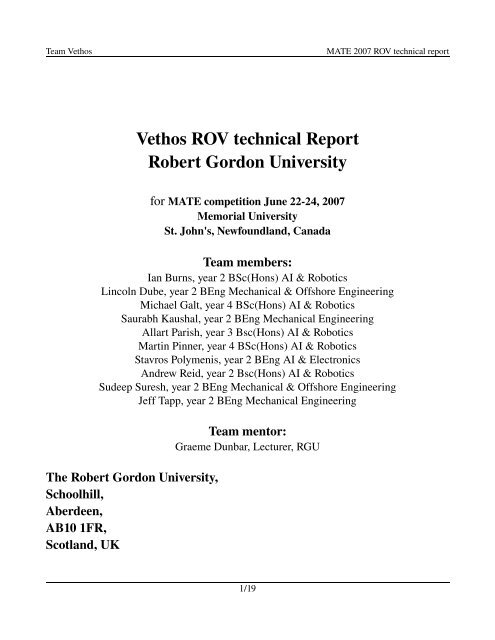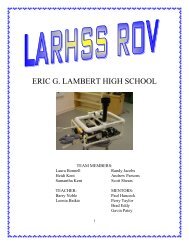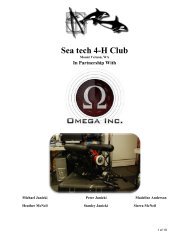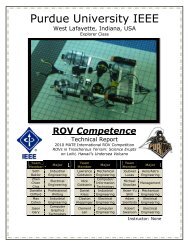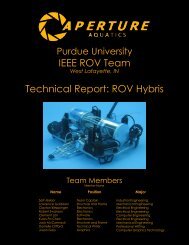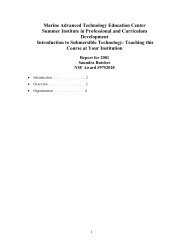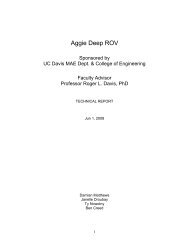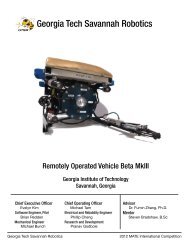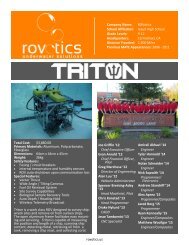Vethos ROV technical Report Robert Gordon University - the Marine ...
Vethos ROV technical Report Robert Gordon University - the Marine ...
Vethos ROV technical Report Robert Gordon University - the Marine ...
Create successful ePaper yourself
Turn your PDF publications into a flip-book with our unique Google optimized e-Paper software.
Team <strong>Vethos</strong>MATE 2007 <strong>ROV</strong> <strong>technical</strong> report2. Expenses5/19
Team <strong>Vethos</strong>MATE 2007 <strong>ROV</strong> <strong>technical</strong> report6/19
Team <strong>Vethos</strong>MATE 2007 <strong>ROV</strong> <strong>technical</strong> report3. ElectronicsThe electronics were divided into two systems. One is control and power which was designedand developed by Stavros Polymenis, and <strong>the</strong> o<strong>the</strong>r is <strong>the</strong> vision which was designed and developed byMichael Galt.3.1 PowerThe <strong>ROV</strong> and its control station are mainly powered by 12 V. The only exception is <strong>the</strong> laptopused as a display, which has a separate power supply. The minimum current draw of <strong>the</strong> whole system(laptop excepted) is about 5A, while <strong>the</strong> maximum is around 25 A. The power is transmitted to <strong>the</strong>vehicle, using two cables.3.2 ControlThe control system is defined as <strong>the</strong> part of <strong>the</strong> electronics responsible for <strong>the</strong> user input formovement, <strong>the</strong> encoding/transmission/decoding of <strong>the</strong> signal, and finally its output to <strong>the</strong> thrusters andtools.Initial ideas involved multiple lines, with analogue signal that would control <strong>the</strong> thrusters anddigital for <strong>the</strong> tools. The idea was soon abandoned since it increased <strong>the</strong> size of <strong>the</strong> te<strong>the</strong>r systemdramatically. A second idea involved <strong>the</strong> use of a couple of micro controllers, one at <strong>the</strong> control stationand one on <strong>the</strong> <strong>ROV</strong>, connected with a serial line. Again this involved several lines going down <strong>the</strong>te<strong>the</strong>r, and a very sensitive system that could jeopardize <strong>the</strong> missions. It was finally decided to usemodel aircraft technologies, to control <strong>the</strong> <strong>ROV</strong>.The first challenge was modifying <strong>the</strong> electronics to transmit <strong>the</strong> signal over a cable instead ofradio waves (radio waves cannot be transmitted within water). The second challenge was to transmit <strong>the</strong>signal over a 20 meter cable with out any loss due to noise and o<strong>the</strong>r signal degeneration effects.Analyzing <strong>the</strong> design from <strong>the</strong> top to bottom (input to output), <strong>the</strong> first subsystem encountered is<strong>the</strong> controller. The controller accepts <strong>the</strong> user input from two joysticks (with two degrees of freedomeach) and a rotational analogue switch. Since <strong>the</strong> radio transmitter could not be used, <strong>the</strong> buddy boxoutput was used to transmit <strong>the</strong> input. Every degree of freedom or function, is translated into a squarewave, were <strong>the</strong> HIGH width (time) is proportional to <strong>the</strong> degree <strong>the</strong> stick is rotated, which is <strong>the</strong>standard encoding method for servo signals. Each function requires a channel. All channels are <strong>the</strong>nmultiplexed into a signal line, with time division. The frames are separated by a long LOW section at<strong>the</strong> end of each cycle. The multiplexed signal is <strong>the</strong>n send to a RS422 line driver, which boosts andtransmits <strong>the</strong> signal down <strong>the</strong> te<strong>the</strong>r over two balanced lines.On <strong>the</strong> receiver end, an RS422 receiver accepts <strong>the</strong> signal, and reverts it back to a single endedsignal. A demultiplexer separated <strong>the</strong> channels and sends each channel to each respective motor driveror actuator. Some of <strong>the</strong> channels are mixed before <strong>the</strong> signal is sent to <strong>the</strong> motor drivers or actuators.The motor drivers are all Mtroniks “Viper <strong>Marine</strong> 15”, and <strong>the</strong> actuators standard servos.7/19
Team <strong>Vethos</strong>MATE 2007 <strong>ROV</strong> <strong>technical</strong> report3.3 VisionThe aim of <strong>the</strong> optical system was to devise a way of delivering imagery of up to four cameras,back to <strong>the</strong> control station. The cameras had to be able to work at least 15 m away from <strong>the</strong> <strong>ROV</strong>. Thesystem had to be robust as <strong>the</strong>re was no way of committing hardware changes while <strong>the</strong> <strong>ROV</strong> isundertaking a challenge.The decided camera system had to be able to solve three issues. Possible incompatibilitiesbetween UK and Canada power and video systems, <strong>the</strong> inability due to rules to use more than 3displays, and transporting a lot of equipment. All <strong>the</strong>se issues were solved by using digital USB webcameras. The drawback of <strong>the</strong> web cams was <strong>the</strong> limitation on <strong>the</strong> length of <strong>the</strong> USB cable. This cablecan only be 5 m long for <strong>the</strong> device to work. As a 15 m range required ano<strong>the</strong>r way of connecting <strong>the</strong>cameras from <strong>ROV</strong> to <strong>the</strong> computer was needed. This was done using a USB extender. This devicetakes <strong>the</strong> signal from a camera and converts it into a signal that can be passed down a cat 5 networkingcable, after traveling down <strong>the</strong> cable <strong>the</strong> device <strong>the</strong>n converts <strong>the</strong> signal back to USB for linking up to acomputer. This device meant that <strong>the</strong> cameras could be up to 50 m away from <strong>the</strong> computer.There were several different USB extenders available from different companies. All <strong>the</strong>sedevices worked <strong>the</strong> same way and were pretty much <strong>the</strong> same. The one that was used was slightlydifferent; instead of an input of one USB port it had four. This made it perfect for our use, since itallowed multiple web cams and it reduced <strong>the</strong> amount of equipment required inside of <strong>the</strong> <strong>ROV</strong>.The web cams that were used had to be from different companies. If two of <strong>the</strong> same web camswere used <strong>the</strong> system would get conflicts as <strong>the</strong> same driver would be used for both, resulting to failure.The cameras used have all <strong>the</strong> same specifications. They all have a resolution of 640 x 480 pixels and aframe rate of 35 frames per second. This gave and adequate size of picture that was also fluid so everymovement could be seen instantly.The software used to create <strong>the</strong> program was C++ Builder. An addon was had also to beincluded this was called “VideoLab”. This addon allowed C++ to input videos from many differentsources and to manipulate <strong>the</strong>se videos in a number of different ways. This setup was chosen for itssimplicity to use and develop software and <strong>the</strong> and because of prior knowledge of using it for this typeof task.The original concept was to have all four web cams displayed on <strong>the</strong> monitor at <strong>the</strong> same time and beable to enlarge one of <strong>the</strong> displays at once. After some experimenting with <strong>the</strong> USB hub and <strong>the</strong>cameras it was discovered that <strong>the</strong> bandwidth of <strong>the</strong> system only allowed two cameras to worksimultaneously and one camera had to be completely shut down before <strong>the</strong> o<strong>the</strong>r could be started or <strong>the</strong>system would crash.The program utilizes a windows based GUI (graphical user interface) which makes all tasks alot simpler. This will be done with <strong>the</strong> use of buttons that <strong>the</strong> user can click on. Each button will enact aseparate part of <strong>the</strong> program.There can be a maximum of two cameras displaying at one time. One camera display is <strong>the</strong>camera located inside of <strong>the</strong> <strong>ROV</strong>. This camera will be started using a button that will enable it andmake this display screen visible. This camera will be <strong>the</strong> only one available for that window. The o<strong>the</strong>rthree camera will be used for tooling and will be all displayed individually in <strong>the</strong> same window. Thecamera that is viewed at a specific time will be selected by <strong>the</strong> user using one of three buttons. Eachbutton will denote a different camera. Pressing a button will close down any o<strong>the</strong>r cameras and make all8/19
Team <strong>Vethos</strong>MATE 2007 <strong>ROV</strong> <strong>technical</strong> reporto<strong>the</strong>r screens not visible. It will <strong>the</strong>n turn on <strong>the</strong> camera selected and make <strong>the</strong> screen for it visible.The interface layout has two windows for <strong>the</strong> camera outputs and <strong>the</strong> buttons for controlling <strong>the</strong>cameras. The camera 1 button enables <strong>the</strong> camera and enables <strong>the</strong> display for it. Camera 2 buttondisables camera 3 and 4 and makes <strong>the</strong>re displays not visible it <strong>the</strong> enables camera 2 and makes itsdisplay visible. The buttons for <strong>the</strong> o<strong>the</strong>r two cameras do <strong>the</strong> same task just for different cameras beingenabled and disabled. The stop all button disables all cameras and displays. The only difference from<strong>the</strong> original design was <strong>the</strong> input of setting buttons. This was added to allow <strong>the</strong> system to be compiledand run independent from <strong>the</strong> programming software. There is a settings button for each of <strong>the</strong> cameras.When pressed this button displays a separate form. On this form <strong>the</strong> camera that is to be used for eachdisplay can be selected from a drop down list.4. FrameThe main frame of <strong>the</strong> <strong>ROV</strong> is made from Georg Fischer 20 mm PVC pipes joined toge<strong>the</strong>r withPVC connectors and glued using solvent cement, it was decided to use this material mainly because of<strong>the</strong> ease to work with PVC. The effect of external pressure on <strong>the</strong> PVC pipes at <strong>the</strong> working depth of<strong>the</strong> <strong>ROV</strong> was taken into consideration before choosing <strong>the</strong> material of construction so as to preventimplosion of any structural members of <strong>the</strong> <strong>ROV</strong>. The frame is sealed and is not free flooding. It wasanticipated it might be difficult to remove all air bubbles in <strong>the</strong> free flooding frame in <strong>the</strong> heat of <strong>the</strong>competition.Critical distortion pressure of <strong>the</strong> PVC pipes, acrylic dome and electronic housing was alsocalculated over a range of different temperatures which <strong>the</strong> <strong>ROV</strong> is likely to be used in, by <strong>the</strong> use ofappropriate derating factors. To mount <strong>the</strong> propellers symmetrically relative to each o<strong>the</strong>r we came upwith a cuboid shape for <strong>the</strong> final structure of <strong>the</strong> <strong>ROV</strong>. The <strong>ROV</strong> measures 560 x 530 x 260 (mm).4.1 ThrustersThe choice of thrusters was down to selecting thrusters that were easily modifiableand fitted <strong>the</strong> power budget. The <strong>ROV</strong> uses a total of 6 type 'Rule 1100 GPH' bilge9/19
Team <strong>Vethos</strong>MATE 2007 <strong>ROV</strong> <strong>technical</strong> reportpumps. Two vertically mounted pumps help <strong>the</strong> <strong>ROV</strong> in its vertical motion and <strong>the</strong> o<strong>the</strong>r four pumpsmounted horizontally provide motions in all directions horizontally.4.2 PropellersThe basis of choosing propellers was purely experimental. Aircraft type propellers and PC fanswere tried out initially but <strong>the</strong>y were found to slow <strong>the</strong> pumps down, causing <strong>the</strong> pumps to drawexcessive current. A source of model boat propellers were found.The propeller diameter to be used with new pumps was calculated using observations madefrom experimentation using type 'Rule 500 GPH' bilge pumps with propellers of 60 mm diameterproviding optimum thrust output without overloading <strong>the</strong> pumps. Thus propeller diameter suitable for<strong>the</strong> power output of <strong>the</strong> new pumps was calculated by scaling <strong>the</strong> sizes from <strong>the</strong> earlier experiment andusing a similar propeller pitch.4.3 PropulsionThe <strong>ROV</strong> uses vectored thrust for its horizontal movements in different directions in order toattain maximum thrust from <strong>the</strong> given set of motors, assuming that <strong>the</strong> thrust is equal in both <strong>the</strong>directions, i.e. <strong>the</strong> pull of <strong>the</strong> thrusters is equal to <strong>the</strong>ir push.This design feature provides <strong>the</strong> total thrust, in any direction, which is greater than <strong>the</strong> thrust which canbe provided by a pair of <strong>the</strong> motors acting in <strong>the</strong> same direction by a factor of 2 .Moreover <strong>the</strong> Propellers used in <strong>the</strong> <strong>ROV</strong> are out turning each o<strong>the</strong>r so as to avoid any sideways dragand thus making <strong>the</strong> <strong>ROV</strong> highly maneuverable. The rate of ascend and descend of <strong>the</strong> also calculatedupon calculating <strong>the</strong> vertical thrust of <strong>the</strong> propellers.T 1T 3=∣T∣ 2 ∣T∣ 2 2∣T∣ 2 cos θ⇒ 2∣T∣ 2 when θ=90 ° ⇒∣T∣2<strong>the</strong>refore sum of thrust⇒ 2∣T∣2where T is thrustT 14545T 345 45T 2T 44.4 BuoyancyThe frame of <strong>the</strong> <strong>ROV</strong> with all <strong>the</strong> electronic components such as motor drivers and thrusters10/19
Team <strong>Vethos</strong>MATE 2007 <strong>ROV</strong> <strong>technical</strong> reportwere made neutrally buoyant by a series of calculations and experiments. During initial calculations <strong>the</strong><strong>ROV</strong> was found to be positively buoyant. In order to make it neutrally buoyant <strong>the</strong> ballast required to betaken was calculated. The <strong>ROV</strong> was weighed on a spring balance to get its total mass, <strong>the</strong> volume ofeach structure and component was calculated independently and <strong>the</strong> necessary calculations were doneto obtain an approximated value of <strong>the</strong> ballast required.The calculated ballast required by <strong>the</strong> <strong>ROV</strong> was confirmed experimentally by adding sufficientweights to <strong>the</strong> <strong>ROV</strong> in <strong>the</strong> form of 3 mild steel bars of density 7860 kg/m 3 and 438 mm in length.Whilst establishing <strong>the</strong> stability of <strong>the</strong> <strong>ROV</strong> <strong>the</strong> transverse and longitudinal metacentric heights (<strong>the</strong>distance between <strong>the</strong> center of gravity and center of buoyancy) were calculated.All <strong>the</strong> o<strong>the</strong>r tools were made neutrally buoyant and fitted on <strong>the</strong> <strong>ROV</strong> so that <strong>the</strong> stability andbuoyancy of <strong>the</strong> <strong>ROV</strong> remained unaffected.4.5 WaterproofingThe pressure vessel of <strong>the</strong> <strong>ROV</strong> is constructed from Marley Plumbing and Drainage 160 mmdiameter PVCu pipe and SE62 Access Caps with pressure plugins which use very reliable rubber Orings and are capable of withstanding <strong>the</strong> pressure encountered by <strong>ROV</strong> during its operations.The cap on <strong>the</strong> bow end was modified to take a 150 mm acrylic dome (from K&M WholesaleSupplies). The cable penetrators on <strong>the</strong> stern end are waterproof IP68 rated cable glands.The force of drag experienced by <strong>the</strong> <strong>ROV</strong> was calculated experimentally to confirm <strong>the</strong><strong>the</strong>oretically calculated value by towing <strong>the</strong> <strong>ROV</strong> at a given speed using a spring balance. The readingon <strong>the</strong> spring balance multiplied by 9.81 N (force gravity) would give <strong>the</strong> value of drag in Newtons.F D= C D ×ρ×V 2 ×A2where CD = Coefficient of drag, p = Density of fluid, v = Velocity, A = Area, F = Force of dragIt was noted that <strong>the</strong> vehicle slowed down when moving sideways and this was due to anincrease in surface area of <strong>the</strong> <strong>ROV</strong> experiencing drag which leads to <strong>the</strong> drop in velocity.N.B. In all <strong>the</strong> calculations due consideration was given to <strong>the</strong> density of water at different temperaturesfor different missions.11/19
Team <strong>Vethos</strong>MATE 2007 <strong>ROV</strong> <strong>technical</strong> report5. Tools5.1 Mission 1 (Allart Parish)The tool for mission one has to be designed to tread a line through an anchor ring. It also has todo this with <strong>the</strong> minimum movement needed from <strong>the</strong> <strong>ROV</strong>. A way of doing this, is to keep a hold of<strong>the</strong> line at all times. This means <strong>the</strong> tool has to thread <strong>the</strong> line through <strong>the</strong> anchor ring and grab <strong>the</strong> linefrom <strong>the</strong> o<strong>the</strong>r side before letting go of <strong>the</strong> first side.To achieve this a mixture of electromagnets and Velcro is used. The reasons for using <strong>the</strong>secomponents are <strong>the</strong> reliability and <strong>the</strong> ability to use <strong>the</strong>m underwater without any modifications. Theelectromagnets are going to be used for two functions: One is to use <strong>the</strong> actuators for <strong>the</strong> arms. To dothis we pace <strong>the</strong> magnets at opposite poles to attract and close <strong>the</strong> arms. Therefore reversing <strong>the</strong>direction of <strong>the</strong> current on one of <strong>the</strong> magnets and thus flipping <strong>the</strong> pole and causing repulsion between<strong>the</strong> two magnets and opening <strong>the</strong> arms. The o<strong>the</strong>r use for <strong>the</strong> electro magnet is to hold <strong>the</strong> end of <strong>the</strong>messenger line to one arm until it can be passed to <strong>the</strong> o<strong>the</strong>r arm at which point <strong>the</strong> line will be held byVelcro. This means <strong>the</strong>re has to be a metal disk with a side of Velcro attached to <strong>the</strong> end of <strong>the</strong>messenger.The tool is neutrally buoyant so when attached to <strong>the</strong> <strong>ROV</strong> <strong>the</strong>re will be no need to adjust <strong>the</strong>buoyancy or <strong>the</strong> ballast of <strong>the</strong> <strong>ROV</strong>. To do this, <strong>the</strong> tubing that is <strong>the</strong> basis of <strong>the</strong> tool is filled withfoam.5.2 Mission 2 (Martin Pinner & Ian Burns)5.2.1 Bethnic jellyfish collectorThis part of mission 2 involves <strong>the</strong> collection of a simulated Jellyfish which has beenrepresented by a child’s toy called an Oball. This Oball is around 110 mm in diameter and is full oflarge diameter holes. Instead, a way of physically moving <strong>the</strong> ball into a net was decided <strong>the</strong> best way ofcollecting it as this method would be a much more secure way of stopping <strong>the</strong> ball from falling out fromall of <strong>the</strong> maneuvers <strong>the</strong> <strong>ROV</strong> has to do to complete its o<strong>the</strong>r tasks for that mission. For this reason,hooks were not widely considered.The inspiration came from a vacuum cleaner for this particular tool. A beater brush from aDyson Vacuum cleaner was used and joined to a modified 500 GPH bilge pump via a belt. The motorhas been connected to a motor controller inside <strong>the</strong> <strong>ROV</strong>. The framework is made of aluminum platingand 6 mm “thick plastic to hold <strong>the</strong> moving parts toge<strong>the</strong>r. To keep <strong>the</strong> Benthic jellyfish ball fromescaping, a hole was cut in <strong>the</strong> bottom of <strong>the</strong> tool and a net was placed in it as well as placing plastictubing at 50 mm intervals along <strong>the</strong> rear of <strong>the</strong> tool. This is to allow <strong>the</strong> use of <strong>the</strong> main onboardcamera to sight <strong>the</strong> ball. The tool is designed to fit on <strong>the</strong> front of <strong>the</strong> <strong>ROV</strong> enabling <strong>the</strong> <strong>ROV</strong> to sit on<strong>the</strong> bottom of <strong>the</strong> pool deck and <strong>the</strong>n as <strong>the</strong> <strong>ROV</strong> drives forwards it will pick up <strong>the</strong> Jellyfish as <strong>the</strong>ycome into view of <strong>the</strong> camera.12/19
Team <strong>Vethos</strong>MATE 2007 <strong>ROV</strong> <strong>technical</strong> report5.2.2 Algae collectorAs part of ano<strong>the</strong>r task in mission 2, simulated algae have to be collected from <strong>the</strong> underside ofa floating ice sheet. This algae is being simulated by pingpong balls which float underneath <strong>the</strong> ice andthis poses a challenge to collect.This new tool utilizes <strong>the</strong> “Venturi Effect” where it creates suction underwater capable ofpulling <strong>the</strong> pingpong/ Algae balls down a tube and <strong>the</strong>n trapping <strong>the</strong>m. One piece of pipe had toolarge of a diameter so ano<strong>the</strong>r pipe was inserted into <strong>the</strong> first one by cutting it along its length todecrease <strong>the</strong> internal diameter. This created a narrow enough tube for <strong>the</strong> Venturi effect to be effective.A “U” bend was <strong>the</strong>n added to keep <strong>the</strong> pingpong balls from escaping and a “Y” joint was fitted tohold <strong>the</strong> bilge pump in place with a removable end piece so <strong>the</strong> balls are easily accessable.5.2.3 Sonar PlacementIn this last task, a sonar sensor has to be accurately placed in a fenced off area in <strong>the</strong> tank. Theoriginal idea was to use an already existing tool made to complete a different mission. The idea behindthis is that it would save time and money during <strong>the</strong> construction and development phase in <strong>the</strong> designof a new tool. This tool would have been <strong>the</strong> same one that is used to thread a string through a ‘U’ boltin mission 1. The idea was dropped however for two important reasons. The first being that this toolwould have required extensive modification and would have taken <strong>the</strong> same amount of time asdeveloping a new tool. Ano<strong>the</strong>r important factor in <strong>the</strong> decision was reliability, should this tool stopworking and was rendered unfixable, that would mean potentially two out of three missions that wouldnot have been possible to complete fully. Instead a new very simple tool was decided on as being <strong>the</strong>most reliable way of completing this particular mission. The idea is to simply hang <strong>the</strong> senor off a hookwith a shallow bend in it. This bend would allow <strong>the</strong> sensor to stay on <strong>the</strong> hook by threading <strong>the</strong> hookthrough <strong>the</strong> chain of <strong>the</strong> sensor device. When <strong>the</strong> senor is placed in <strong>the</strong> fenced off area <strong>the</strong> <strong>ROV</strong> wouldsimply reverse to release it (as <strong>the</strong> sensor would be resting at <strong>the</strong> bottom of <strong>the</strong> tank and <strong>the</strong> tension of<strong>the</strong> chain would be slack).5.3 Mission 3 (Andrew Reid & Martin Pinner)An important element of this mission is orientation, without some way to anchor <strong>the</strong> <strong>ROV</strong>around <strong>the</strong> wellhead it would be very difficult to accurately land <strong>the</strong> gasket and wellhead cover in place.With this is mind <strong>the</strong> first piece of tooling designed was a clip to be mounted on <strong>the</strong> front of <strong>the</strong> <strong>ROV</strong>allowing it to attach, rotate around <strong>the</strong> wellhead, and also move vertically while keeping <strong>the</strong> wellheadin reach of <strong>the</strong> rest of <strong>the</strong> tools.Originally for this mission, electrical solenoids were to be used to pick up and drop <strong>the</strong> gasketand wellhead cover, however once <strong>the</strong> tool was built, <strong>the</strong> solenoids proved <strong>the</strong>mselves to be unreliable.Consequently, since time and manpower were both in short supply, a system of hooks was designed,one hook to carry down and drop <strong>the</strong> gasket, ano<strong>the</strong>r to pick up and replace <strong>the</strong> cover.Since an additional degree of freedom was required to effectively use <strong>the</strong> hooks, <strong>the</strong> clip at <strong>the</strong>front was connected at a pivot, allowing <strong>the</strong> <strong>ROV</strong> to twist around <strong>the</strong> wellhead. With one hook carryingdown <strong>the</strong> gasket, <strong>the</strong> o<strong>the</strong>r beginning empty. First, <strong>the</strong> <strong>ROV</strong> must fly down and attach <strong>the</strong> clip to <strong>the</strong>wellhead, use one hook to catch and lift (by using vertical movement still centered on <strong>the</strong> wellhead) <strong>the</strong>cover, twist <strong>the</strong> <strong>ROV</strong> about <strong>the</strong> pivot, use <strong>the</strong> second hook to drop <strong>the</strong> gasket, twist back and replace <strong>the</strong>13/19
Team <strong>Vethos</strong>MATE 2007 <strong>ROV</strong> <strong>technical</strong> reportcover.The hot stab release works in a similar way, <strong>the</strong> clip is used to center around <strong>the</strong> insertion point,a one shot release mechanism is used, a bilge pump motor used to shoot out <strong>the</strong> hot stab, which will beattached by a string, so when <strong>the</strong> <strong>ROV</strong> flies away <strong>the</strong> stab follows, keeping <strong>the</strong> system as simple aspossible.14/19
Team <strong>Vethos</strong>MATE 2007 <strong>ROV</strong> <strong>technical</strong> report6. Challenges & ExperiencesDuring <strong>the</strong> course of <strong>the</strong> project, <strong>the</strong> team was met with a variety of challenges ranging fromsoftware to hardware and from electronics to finance. These next few paragraphs discuss <strong>the</strong>se issues ingreater depth and what was done as a team to overcome <strong>the</strong>m.By far <strong>the</strong> biggest hurdle was simply <strong>the</strong> very short period of time we had to plan, prepare, getfunding, construct, test and develop <strong>the</strong> <strong>ROV</strong>. However, this was tackled by breaking each problemdown in to goals that each team member had to reach. Once reached, (some sooner than o<strong>the</strong>rs), <strong>the</strong>members <strong>the</strong>n joined <strong>the</strong> o<strong>the</strong>r tasks to help complete <strong>the</strong>m faster. With this structured approach wewere able to complete <strong>the</strong> challenges as <strong>the</strong>y arose.One such problem that was tackled was <strong>the</strong> decision of what to use for <strong>the</strong> drive motors. Bilgepumps were <strong>the</strong> first choice as <strong>the</strong>se were already water tight and were small enough to fit comfortablyin <strong>the</strong> <strong>ROV</strong>. As <strong>the</strong>se had been used successfully in o<strong>the</strong>r <strong>ROV</strong>s <strong>the</strong> decision was made to use <strong>the</strong>m,1100 GPH pumps were chosen for <strong>the</strong>re optimum performance for power and current draw.This <strong>the</strong>n gave <strong>the</strong> team a bench mark as to what size <strong>the</strong> <strong>ROV</strong> was going to be when designing<strong>the</strong> chassis with only <strong>the</strong> tooling (needed to complete each challenge) yet to determine <strong>the</strong> final size.The chassis was designed open plan (no side panels and built around a frame) which allowed easyaccess to various areas should <strong>the</strong>y need to be accessed for maintenance and it also allowed for easyattachment/detachment for tooling and reduced <strong>the</strong> drag as much as possible. It wasn’t until a prototypeof <strong>the</strong> largest tool (<strong>the</strong> ping pong ball collector for mission two) was made could <strong>the</strong> final height bedetermined. This tool was <strong>the</strong> longest <strong>the</strong>refore <strong>the</strong> chassis had to be tall enough to encapsulate it. Mostof <strong>the</strong> o<strong>the</strong>r tools were designed around sizes of <strong>the</strong> chassis where possible.The challenge that took <strong>the</strong> longest to solve was <strong>the</strong> electronics. As <strong>the</strong>re wasn’t enough time tomake a fully custom control system, <strong>the</strong> decision was made to use a hobby Radio Control (RC)transmitter and adapt it for umbilical use (as it’s receiver can’t be used underwater as <strong>the</strong> radio wavesare absorbed by <strong>the</strong> water and by o<strong>the</strong>r contaminants). The controller has what’s known as a TrainerCord socket which is used by <strong>the</strong> hobby RC community to connect two RC transmitters toge<strong>the</strong>r in aslave/master configuration so that a novice flier can be ‘backedup’ by an expert so <strong>the</strong>y don’t crash<strong>the</strong>ir vehicle. The signals coming from <strong>the</strong> master controller override those of <strong>the</strong> slave controller andcontrol of <strong>the</strong> vehicle is regained (in <strong>the</strong>ory). This ‘signal’ is sent in a multiplexed form down <strong>the</strong> cableand can be used to control RC equipment such as speed controllers and servos. With <strong>the</strong> use of a circuitonboard <strong>the</strong> <strong>ROV</strong> which separates <strong>the</strong> signals (using a demultiplexer) and translates <strong>the</strong>m in tosomething <strong>the</strong> RC equipment can understand. One issue that arose during <strong>the</strong> testing of <strong>the</strong> controlcircuitry was that it was highly susceptible to interference, especially with <strong>the</strong> length of umbilicalneeded for <strong>the</strong> <strong>ROV</strong>. To get around this, line drivers are used at each end of <strong>the</strong> control lines of <strong>the</strong>umbilical to filter out and boost <strong>the</strong>se sensitive control signals.15/19
Team <strong>Vethos</strong>MATE 2007 <strong>ROV</strong> <strong>technical</strong> report7. TroubleshootingThe team had to face several problems that were not foreseen in <strong>the</strong> design process. Most of<strong>the</strong>se problems occurred during <strong>the</strong> test runs and <strong>the</strong> experimenting.One of <strong>the</strong>m was <strong>the</strong> camera located inside <strong>the</strong> pressure vessel. During <strong>the</strong> test run <strong>the</strong> pilot washaving difficulty understanding what <strong>the</strong> camera was viewing due to <strong>the</strong> very limited angle andresolution of <strong>the</strong> camera. Thus <strong>the</strong> camera had to be replaced with a better one, which features biggerresolution and viewing angle.Ano<strong>the</strong>r issue discovered during <strong>the</strong> test run was that <strong>the</strong> control system was resetting atconstant intervals with a certain input. This took <strong>the</strong> <strong>ROV</strong> back to <strong>the</strong> electronics labs for fur<strong>the</strong>r tests,which proved that <strong>the</strong> issue was caused by bad grounding. The problem was quickly resolved.16/19
Team <strong>Vethos</strong>MATE 2007 <strong>ROV</strong> <strong>technical</strong> report8. Lessons & SkillsThroughout <strong>the</strong> research and development stage, and during <strong>the</strong> testing runs, <strong>the</strong> team hadimportant lessons only real life engineering applications can give, and acquired useful skills.To begin with most of <strong>the</strong> team members have never worked in such a large scale group, whereso many people are involved, with limited budgets, timing schedules, reports etc. This is what real lifeengineering jobs are like thought, and it is extremely useful for an engineer to acquire skills such ascommunication and cooperation during <strong>the</strong>ir academic time. The crew members had to keep in touch inperson and over IT services (like emails, forums, etc), organize meetings, lab sessions and transfer andshare data.Fur<strong>the</strong>r more team members had a unique opportunity to apply <strong>the</strong> <strong>the</strong>oretical knowledge <strong>the</strong>yhave ga<strong>the</strong>r so far. It is normal and expected that an engineer will not get to learn about little detailsduring <strong>the</strong>ir training, which really make <strong>the</strong> difference. These details are only faced and tackled once anengineer gets a real life tasks. Examples of such details are <strong>the</strong> materials used and <strong>the</strong> reasoning forthat, what connectors were chosen for a specific application, <strong>the</strong>ir features etc.But <strong>the</strong> most important skill acquired, is creative thinking. All team members had to performresearches, design and experiment, for <strong>the</strong> various problems that had to be tackled. The team membershad to learn about Radio Control technologies, <strong>the</strong> Venturi Effect, buoyancy and hydraulics and o<strong>the</strong>r<strong>the</strong>ories and techniques. These were <strong>the</strong>n analyzed, tweaked, experimented, and applied to result into asuitable choice for <strong>the</strong> task.9. Future ImprovementsAs mentioned above, this <strong>ROV</strong> was developed over a tiny period. This makes this first versiononly a testing one, through which important information will be ga<strong>the</strong>red during this years competitionin order to find in which fields <strong>the</strong> team is on <strong>the</strong> right track and in which fields <strong>the</strong> team had to reviseor change <strong>the</strong> specific system.So far <strong>the</strong> team knows that a definite change for next year is to improve <strong>the</strong> quality and <strong>the</strong>design standards of <strong>the</strong> electronics. If <strong>the</strong> current technologies prove effective and efficient, <strong>the</strong>y will beimproved in order to become more robust and easier to use.The current thrusters are likely to change as well, as more efficient and powerful ones can bedesigned or bought provided <strong>the</strong>re is enough time for <strong>the</strong> team to research <strong>the</strong> subject.Finally <strong>the</strong> chassis will have to change to support new functions and modules that will beintroduced in next years version.17/19
Team <strong>Vethos</strong>MATE 2007 <strong>ROV</strong> <strong>technical</strong> report10. Life at PolesAberdeen and Scotland have a longstanding relationship with <strong>the</strong> Inuit of <strong>the</strong> Canadian Arctic.The following is about <strong>the</strong> adventures shared by a Scotsman William Perry and an Inuit, Inuluapik in<strong>the</strong> 1800.William Penny born in Peterhead Scotland located a few miles north of Aberdeen in 1809. Hebecame a mate before 21 and by <strong>the</strong> time he turned 26 he was commanding his own whaling vessel.Between 1821 and 1864 he sailed between Scotland and <strong>the</strong> Arctic whaling and sealing ground oftensometimes twice a year. It was in 1839 that William Perry met and befriended a young Inuit mannamed Inuluapic. Inuluapik was exceptionally familiar with <strong>the</strong> area and impressed by this localknowledge, Perry convinced Inuluapik to travel with him to Aberdeen to spend <strong>the</strong> winter, in exchangefor Inuluapik’s helping to find and map Cumberland Sound. Perry did have an ulterior motive withinviting <strong>the</strong> young Inuit to Scotland in that he hoped to gain publicity and public support for <strong>the</strong>exploratory voyage. After a ceremonial goodbye from his mo<strong>the</strong>r and family Inuluapik set off withPenny for Aberdeen sometime in October 1839. The ship arrived at Aberdeen harbour on November 8but almost immediately Inuluapik caught a potentially life threatening lung infection. Only a few daysafter his arrival, and still being ill from <strong>the</strong> lung infection, Penny managed to convince Inuluapic tomake a public appearance. Dressed in Full fur dress, Inuluapik gave a kayaking demonstration in <strong>the</strong>River Dee which resulted in a recurrence of Inuluapic’s infection confining him to bed for 14 days andhampering his health for <strong>the</strong> remainder of his stay in Scotland.Failing to get any government funds to pay for his expedition Penny and Inuluapik set off aboard<strong>the</strong> Whaling Ship Bon Accord, for <strong>the</strong> Davis Strait on April 1 st, arriving on May 5 th . Penny and hisintrepid Inuit companion first made <strong>the</strong>re way to <strong>the</strong> Melville Bay to earn money Whaling to pay for <strong>the</strong>expedition, and by July had earned enough to begin making <strong>the</strong>re way south to look for <strong>the</strong> inlet toCumberland Sound. It was on July 27, 1840 that William Penny and Inuluapik found Cumberlandsound though at first he thought that it was an unknown channel and named it Hogarth’s Sound, it tooka few years for <strong>the</strong> error to be recognized and fixed.They followed <strong>the</strong> northeast shoreline until <strong>the</strong>y were able to cross <strong>the</strong> sound to Inuluapik’sbirthplace Qimmiqsut where <strong>the</strong>y were greeted by a party of Inuit, 2 of which were cousins ofInuluapik. Inuluapik talked a little of his travels but kept his discussions mostly to <strong>the</strong> GreenlandCoastline and peoples and demonstrated <strong>the</strong> gun that Penny had given Inuluapik as a present inScotland, most likely because Inuluapik knew that <strong>the</strong>se things would be of more interest to his fellowInuit <strong>the</strong>n his travels to Scotland. Not long after this Inuluapik and Perry parted ways and Perryreturned home empty handed thinking that his exploratory mission was a failure. Yet in <strong>the</strong> yearsfollowing Inuluapik and Perry’s adventures toge<strong>the</strong>r, Cumberland sound was to become one of <strong>the</strong> mostimportant whaling grounds in <strong>the</strong> Canadian artic.Life at Poles bibliography:http://www.nunatsiaq.com/archives/50729/opinionEditorial/columns.htmlhttp://pubs.aina.ucalgary.ca/arctic/Arctic364380.pdf18/19
Team <strong>Vethos</strong>MATE 2007 <strong>ROV</strong> <strong>technical</strong> report11. AcknowledgmentsWe are very grateful for <strong>the</strong> support and sponshorship of many people and organisationsincluding <strong>the</strong> following:Subsea 7, has been a major financial and <strong>technical</strong> supporter of our project. Our graditute goesto Mr. Neil Milne and <strong>the</strong> staff at Subsea 7 in Aberdeen for a tour of <strong>the</strong> facilities and use of <strong>the</strong>ir tanksfor testing <strong>the</strong> <strong>ROV</strong>. Special mention goes to Mr. Bob Curtis for his encouragment and inspirationalhelp.We are grateful to Mr. Curtis and Mr. Mark Slessor of Oceaneering for bringing <strong>the</strong> competitionand <strong>the</strong> teams efforts to <strong>the</strong> attention of bussinesses in Aberdeen and driving <strong>the</strong> sponshorship.Acknowledgments go to C.R. Encapsulation (www.creltd.co.uk), FugroRovtech Ltd(www.rovtech.co.uk), MacArtney UK Ltd (www.macartney.com), Oceaneering InterventionEngineering (www.oceaneering.com), Tritech International Ltd (www.tritech.co.uk), for <strong>the</strong>irsponshorship.The team would like to thank our mentor, Mr. Graeme Dunbar for all <strong>the</strong> assistance he has givenus with this project.Last but not least <strong>the</strong> team would like to acknowledge <strong>the</strong> support provided to us by The <strong>Robert</strong><strong>Gordon</strong> <strong>University</strong>. The staff have been extremely helpful and cooperative in providing various kinds ofsupport. In specific we would like to thank Mr. Bill Walker and <strong>the</strong> <strong>technical</strong> staff in <strong>the</strong> workshop forfabrication of parts for <strong>the</strong> <strong>ROV</strong>. A specific mention of Mr. John Still for his assistance in <strong>the</strong> electronicsystems of <strong>the</strong> <strong>ROV</strong>. Fur<strong>the</strong>r more RGU kindly covered all <strong>the</strong> expenses required for <strong>the</strong> manufacturingof <strong>the</strong> <strong>ROV</strong>.19/19


